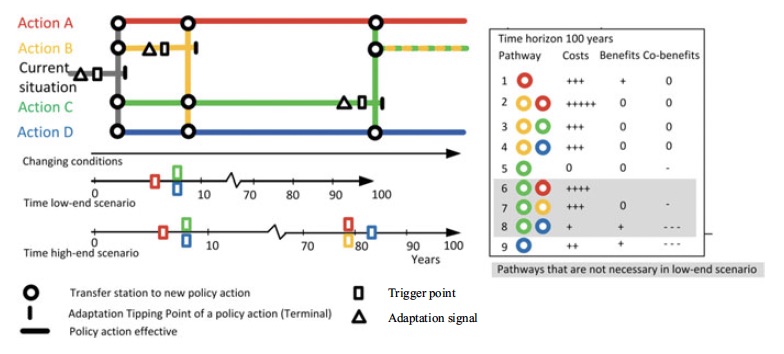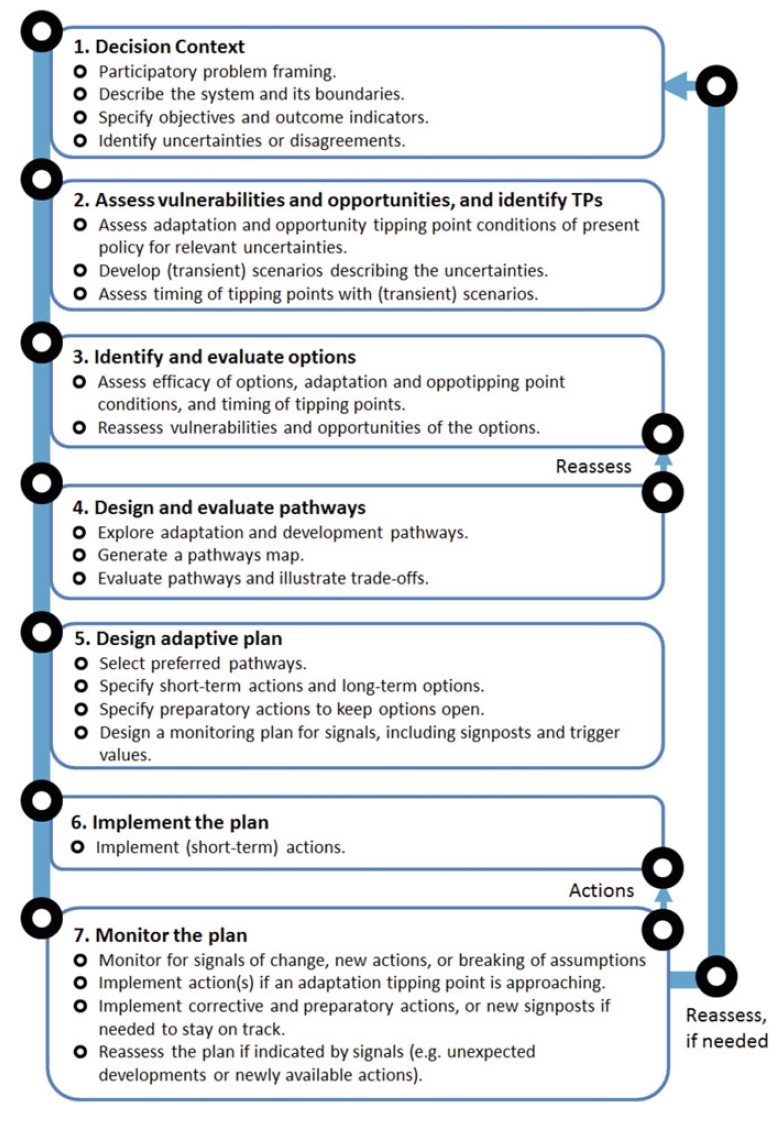When to use
DAPP [1] aims at guiding the design of a robust and adaptive plan as a sequence of actions (near term and alternative future actions) over time through [2]:
- exploration of sequences of decisions through an adaptation pathways approach. This provides a portfolio of plausible robust and adaptive actions, consisting of near term and long term options, to be used within adaptive pathways for a system to cope under plausible futures (i.e., scenarios)
- making visible path dependency of alternative future strategies
DAPP also supports participatory modelling through engaging stakeholders and decision makers in problem-solving activities [2,3]
The approach was originally built to implement climate-resilient pathways for long-term water resources strategic planning but can be applied to other long-term strategic planning problems under deep uncertainty [2,13]
The approach is useful [2]:
- when applied to facilitate decision-making understanding and to support the acknowledgement of uncertainties in plans
- as an enabler for action
- when considering coupled physical-technical-human systems and long time planning horizons
- when considering the potential for implementing alternative adaptation actions to solve issues according to how the future may unfold
Operationalising the DAPP approach requires:
- setting the scene for a system of interest and defining a vision [2]
- defining narratives describing future plausible conditions [2]
- identifying indicators of change for the system and for actions and associated threshold values [2]
- stakeholder buy-in and engagement in relevant activities [3]
- considering the intervention of local knowledge-brokers to facilitate the application of the approach and stakeholder engagement [3]
How
The DAPP framework can be decomposed into eight main iterative steps [2]:
- Participatory problem framing, defining:
- boundaries of a system of interest
- performance objectives, including conditions of success for the system used to evaluate performance of policy options
- current and future vulnerabilities (i.e., conditions/risk factors for which the system (will) fail to achieve acceptable objectives). Vulnerabilities may be:
- intended to be managed by actions or policy options, e.g., reservoir development to support water users and associated uses, education to support the adoption of best practices, microirrigation systems to improve water efficient uses at the field level
- non-manageable factors with uncertainty as to how they may evolve, to be described within narratives (scenarios), e.g., climate change, national legislation, global markets, population growth.
- Identification of adaptation tipping points (ATPs), i.e. conditions and timing of failure for the current system when facing different future scenarios. Approaches to identify ATPs (i.e., threshold values) include:
- 'bottom-up' approaches: stress tests through sensitivity analyses, scenario discovery [5], expert judgement [1], and/or stakeholder consultation [3]
- 'top-down' approaches: model-based assessment using static or transient [9] scenarios
- Identification of alternative actions based on step 1 and 2, to address identified vulnerabilities or opportunities, followed by determination of their ATPs
- Design and assessment of the adaptive pathways. This stage leads to the design of a pathway map (see figure below), also referred to as a "metro map", with different pathways evaluated in terms of performance objectives for the system [2].
- drawing them manually
- using a dedicated application such as the Pathways Generator [4]
- based on models such as agent-based models [14], using multi-objective robust optimisation [6], serious games [7,8]
- during stakeholder focus group discussions [3]
- using a combination of model-based assessment and group discussions
- The performance of each pathway is then evaluated and recorded in a scorecard. Methods of evaluation include:
- cost-benefit analysis [16]
- multi-criteria analysis [12]
- real options analysis [12]
- Design of the adaptive strategy in terms of:
- Selection of near term and alternative (long-term) actions from the map
- Contingency actions to support the achievement of the selected pathways
- A monitoring plan, describing signposts (indicators) and triggers (threshold values) for implementing or not actions according to future conditions
- Implementation of the adaptive plan
- Monitoring of the strategy and re-evaluation of the plan, if necessary
Opportunities, no-regret actions, lock-ins and their associated timing of implementation under changing conditions can be inferred from the map.

The summary figure provided by Haasnoot et al. [2] is shown below.

